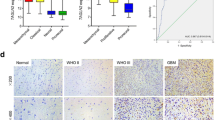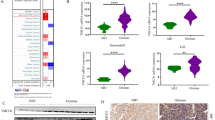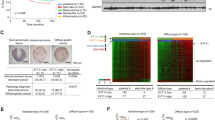Abstract
Purpose
The transition of cells from the epithelial to the mesenchymal state (EMT) plays an important role in tumor progression. EMT allows cells to acquire mobility, stem-like behavior and resistance to apoptosis and drug treatment. These features turn EMT into a central process in tumor biology. Ion channels are attractive targets for the treatment of cancer since they play critical roles in controlling a wide range of physiological processes that are frequently deregulated in cancer. Here, we investigated the role of ether-a-go-go-related 1 (hERG1) ion channels in the EMT of colorectal cancer cells.
Methods
We studied the epithelial-mesenchymal profile of different colorectal cancer-derived cell lines and the expression of hERG1 potassium channels in these cell lines using real-time PCR. Next, we knocked down hERG1 expression in HCT116 cells using lentivirus mediated RNA interference and characterized the hERG1 silenced cells in vitro and in vivo. Finally, we investigated the capacity of riluzole, an ion channel-modulating drug used in humans to treat amyotrophic lateral sclerosis, to reduce the resistance of the respective colorectal cancer cells to the chemotherapeutic drug cisplatin.
Results
We found that of the colorectal cancer-derived cell lines tested, HCT116 showed the highest mesenchymal profile and a high hERG1 expression. Subsequent hERG1 expression knockdown induced a change in cell morphology, which was accompanied by a reduction in the proliferative and tumorigenic capacities of the cells. Notably, we found that hERG1expression knockdown elicited a reversion of the EMT profile in HCT116 cells with a reacquisition of the epithelial-like profile. We also found that riluzole increased the sensitivity of HCT116 cisplatin-resistant cells to cisplatin.
Conclusions
Our data indicate that hERG1 plays a role in the EMT of colorectal cancer cells and that its knockdown reduces the proliferative and tumorigenic capacities of these cells. In addition, we conclude that riluzole may be used in combination with cisplatin to reduce chemo-resistance in colorectal cancer cells.







Similar content being viewed by others
References
J. Guinney, R. Dienstmann, X. Wang, A. de Reynies, A. Schlicker, C. Soneson, L. Marisa, P. Roepman, G. Nyamundanda, P. Angelino, B.M. Bot, J.S. Morris, I.M. Simon, S. Gerster, E. Fessler, E.M.F. De Sousa, E. Missiaglia, H. Ramay, D. Barras, K. Homicsko, D. Maru, G.C. Manyam, B. Broom, V. Boige, B. Perez-Villamil, T. Laderas, R. Salazar, J.W. Gray, D. Hanahan, J. Tabernero, R. Bernards, S.H. Friend, P. Laurent-Puig, J.P. Medema, A. Sadanandam, L. Wessels, M. Delorenzi, S. Kopetz, L. Vermeulen, S. Tejpar, The consensus molecular subtypes of colorectal cancer. Nat Med 21, 1350–1356 (2015)
M.M. Hahn, R.M. de Voer, N. Hoogerbrugge, M.J. Ligtenberg, R.P. Kuiper, A.G. van Kessel, The genetic heterogeneity of colorectal cancer predisposition - guidelines for gene discovery. Cell Oncol 39, 491–510 (2016)
A. Loboda, M.V. Nebozhyn, J.W. Watters, C.A. Buser, P.M. Shaw, P.S. Huang, L. Van't Veer, R.A. Tollenaar, D.B. Jackson, D. Agrawal, H. Dai, T.J. Yeatman, EMT is the dominant program in human colon cancer. BMC Med Genet 4, 9 (2011)
R. Kalluri, R.A. Weinberg, The basics of epithelial-mesenchymal transition. J Clin Invest 119, 1420–1428 (2009)
A. Sathyanarayanan, K.S. Chandrasekaran, D. Karunagaran, microRNA-145 modulates epithelial-mesenchymal transition and suppresses proliferation, migration and invasion by targeting SIP1 in human cervical cancer cells. Cell Oncol 40, 119–131 (2017)
S. Bugide, V.K. Gonugunta, V. Penugurti, V.L. Malisetty, R.K. Vadlamudi, B. Manavathi, HPIP promotes epithelial-mesenchymal transition and cisplatin resistance in ovarian cancer cells through PI3K/AKT pathway activation. Cell Oncol 40, 133–144 (2017)
J.P. Thiery, J.P. Sleeman, Complex networks orchestrate epithelial-mesenchymal transitions. Nat Rev Mol Cell Biol 7, 131–142 (2006)
H. Hugo, M.L. Ackland, T. Blick, M.G. Lawrence, J.A. Clements, E.D. Williams, E.W. Thompson, Epithelial--mesenchymal and mesenchymal--epithelial transitions in carcinoma progression. J Cell Physiol 213, 374–383 (2007)
B. Baum, J. Settleman, M.P. Quinlan, Transitions between epithelial and mesenchymal states in development and disease. Semin Cell Dev Biol 19, 294–308 (2008)
J. Yang, R.A. Weinberg, Epithelial-mesenchymal transition: At the crossroads of development and tumor metastasis. Dev Cell 14, 818–829 (2008)
K. Polyak, R.A. Weinberg, Transitions between epithelial and mesenchymal states: Acquisition of malignant and stem cell traits. Nat Rev Cancer 9, 265–273 (2009)
S. Corallino, M.G. Malabarba, M. Zobel, P.P. Di Fiore, G. Scita, Epithelial-to-mesenchymal plasticity harnesses endocytic circuitries. Front Oncol 5, 45 (2015)
M. Zeisberg, E.G. Neilson, Biomarkers for epithelial-mesenchymal transitions. J Clin Invest 119, 1429–1437 (2009)
J.H. Taube, J.I. Herschkowitz, K. Komurov, A.Y. Zhou, S. Gupta, J. Yang, K. Hartwell, T.T. Onder, P.B. Gupta, K.W. Evans, B.G. Hollier, P.T. Ram, E.S. Lander, J.M. Rosen, R.A. Weinberg, S.A. Mani, Core epithelial-to-mesenchymal transition interactome gene-expression signature is associated with claudin-low and metaplastic breast cancer subtypes. Proc Natl Acad Sci U S A 107, 15449–15454 (2010)
K. Kunzelmann, Ion channels and cancer. J Membr Biol 205, 159–173 (2005)
J.R. Schwarz, C.K. Bauer, Functions of erg K+ channels in excitable cells. J Cell Mol Med 8, 22–30 (2004)
L.A. Pardo, D. del Camino, A. Sanchez, F. Alves, A. Bruggemann, S. Beckh, W. Stuhmer, Oncogenic potential of EAG K(+) channels. EMBO J 18, 5540–5547 (1999)
B. Hemmerlein, R.M. Weseloh, F. Mello de Queiroz, H. Knotgen, A. Sanchez, M.E. Rubio, S. Martin, T. Schliephacke, M. Jenke, R. Heinz Joachim, W. Stuhmer, L.A. Pardo, Overexpression of Eag1 potassium channels in clinical tumours. Mol Cancer 5, 41 (2006)
M. Spitzner, J. Ousingsawat, K. Scheidt, K. Kunzelmann, R. Schreiber, Voltage-gated K+ channels support proliferation of colonic carcinoma cells. FASEB J 21, 35–44 (2007)
A. Litan, S.A. Langhans, Cancer as a channelopathy: Ion channels and pumps in tumor development and progression. Front Cell Neurosci 9, 86 (2015)
V.R. Rao, M. Perez-Neut, S. Kaja, S. Gentile, Voltage-gated ion channels in cancer cell proliferation. Cancers 7, 849–875 (2015)
S.M. Huber, G.S. Braun, S. Segerer, R.W. Veh, M.F. Horster, Metanephrogenic mesenchyme-to-epithelium transition induces profound expression changes of ion channels. Am J Physiol Renal Physiol 279, F65–F76 (2000)
J. Hu, K. Qin, Y. Zhang, J. Gong, N. Li, D. Lv, R. Xiang, X. Tan, Downregulation of transcription factor Oct4 induces an epithelial-to-mesenchymal transition via enhancement of Ca2+ influx in breast cancer cells. Biochem Biophys Res Commun 411, 786–791 (2011)
F.M. Davis, A.A. Peters, D.M. Grice, P.J. Cabot, M.O. Parat, S.J. Roberts-Thomson, G.R. Monteith, Non-stimulated, agonist-stimulated and store-operated Ca2+ influx in MDA-MB-468 breast cancer cells and the effect of EGF-induced EMT on calcium entry. PLoS One 7, e36923 (2012)
I. Restrepo-Angulo, C. Sanchez-Torres, J. Camacho, Human EAG1 potassium channels in the epithelial-to-mesenchymal transition in lung cancer cells. Anticancer Res 31, 1265–1270 (2011)
A. Schwab, C. Stock, Ion channels and transporters in tumour cell migration and invasion. Philos Trans R Soc Lond Ser B Biol Sci 369, 20130102 (2014)
O. Crociani, F. Zanieri, S. Pillozzi, E. Lastraioli, M. Stefanini, A. Fiore, A. Fortunato, M. D'Amico, M. Masselli, E. De Lorenzo, L. Gasparoli, M. Chiu, O. Bussolati, A. Becchetti, A. Arcangeli, hERG1 channels modulate integrin signaling to trigger angiogenesis and tumor progression in colorectal cancer. Sci Rep 3, 3308 (2013)
B. Hille, Ion channels of excitable membranes, 3rd edn. (Sinauer, Sunderland, Mass, 2001)
N.M. Hogan, R.M. Dwyer, M.R. Joyce, M.J. Kerin, Mesenchymal stem cells in the colorectal tumor microenvironment: Recent progress and implications. Int J Cancer 131, 1–7 (2012)
J. Lam, N. Coleman, A.L. Garing, H. Wulff, The therapeutic potential of small-conductance KCa2 channels in neurodegenerative and psychiatric diseases. Expert Opin Ther Targets 17, 1203–1220 (2013)
A. Sankaranarayanan, G. Raman, C. Busch, T. Schultz, P.I. Zimin, J. Hoyer, R. Kohler, H. Wulff, Naphtho[1,2-d]thiazol-2-ylamine (SKA-31), a new activator of KCa2 and KCa3.1 potassium channels, potentiates the endothelium-derived hyperpolarizing factor response and lowers blood pressure. Mol Pharmacol 75, 281–295 (2009)
E. Lastraioli, L. Guasti, O. Crociani, S. Polvani, G. Hofmann, H. Witchel, L. Bencini, M. Calistri, L. Messerini, M. Scatizzi, R. Moretti, E. Wanke, M. Olivotto, G. Mugnai, A. Arcangeli, herg1 gene and HERG1 protein are overexpressed in colorectal cancers and regulate cell invasion of tumor cells. Cancer Res 64, 606–611 (2004)
R. Schonherr, B. Rosati, S. Hehl, V.G. Rao, A. Arcangeli, M. Olivotto, S.H. Heinemann, E. Wanke, Functional role of the slow activation property of ERG K+ channels. Eur J Neurosci 11, 753–760 (1999)
M.W. Pfaffl, A new mathematical model for relative quantification in real-time RT-PCR. Nucleic Acids Res 29, e45 (2001)
A. Fortunato, L. Gasparoli, S. Falsini, L. Boni, A. Arcangeli, An analytical method for the quantification of hERG1 channel gene expression in human colorectal cancer. Diagn Mol Pathol 22, 215–221 (2013)
T.C. Chou, P. Talalay, Theoretical basis, experimental design, and computerized simulation of synergism and antagonism in drug combination studies. Pharmacol Rev 58, 621–681 (2006) Erratum in: Pharmacol. Rev. 59, 124 (2007)
E.L. Lee, Y. Hasegawa, T. Shimizu, Y. Okada, IK1 channel activity contributes to cisplatin sensitivity of human epidermoid cancer cells. Am J Physiol Cell Physiol 294, C1398–C1406 (2008)
R. Paduch, The role of lymphangiogenesis and angiogenesis in tumor metastasis. Cell Oncol 39, 397–410 (2016)
L. Guasti, O. Crociani, E. Redaelli, S. Pillozzi, S. Polvani, M. Masselli, T. Mello, A. Galli, A. Amedei, R.S. Wymore, E. Wanke, A. Arcangeli, Identification of a posttranslational mechanism for the regulation of hERG1 K+ channel expression and hERG1 current density in tumor cells. Mol Cell Biol 28, 5043–5060 (2008)
X. Huang, L.Y. Jan, Targeting potassium channels in cancer. J Cell Biol 206, 151–162 (2014)
S. Dasari, P.B. Tchounwou, Cisplatin in cancer therapy: Molecular mechanisms of action. Eur J Pharmacol 740, 364–378 (2014)
J.W. Albers, V. Chaudhry, G. Cavaletti and R.C. Donehower, Interventions for preventing neuropathy caused by cisplatin and related compounds. Cochrane Database Syst Rev, CD005228 (2014)
J. Killestein, N.F. Kalkers, C.H. Polman, Glutamate inhibition in MS: The neuroprotective properties of riluzole. J Neurol Sci 233, 113–115 (2005)
Acknowledgements
I would like to thank Annarosa Arcangeli, Massimo D’Amico, Elena Morelli, Serena Pillozzi, Antonella Mannini, Olivia Crociani, Sara Falsini, Luca Gasparoli and Ivo Noci for advice and support.
Author information
Authors and Affiliations
Corresponding author
Ethics declarations
Conflicts of interest
The author declares no conflict of interest.
Funding
This research did not receive any specific grant from funding agencies in the public, commercial, or not-for-profit sectors and it was partially supported by the University of Florence, Italy.
Electronic supplementary material
Figure 1S
hERG1 isoforms. Protein coding isoforms of the hERG1 gene. Arrows indicate the shRNAs complementary target sequences. Box: exon; grey box: protein coding sequence; box not filled: untranslated sequence; line between boxes: intron. (PDF 17.6 kb)
Figure 2S
Western blot analysis. Western blot image of total protein analysis of different samples of control (pLKO.1–1, 2) and silenced cells (sh7–1, 2, 3, 4). (PDF 171 kb)
Figure 3S
KCa3.1 gene expression in HCT116, HCT8, HT29 and H630 colorectal cancer cells (PDF 79.1 kb)
Table 1S
Sequences of primers. Sequences of primers (5′-3′). (XLSX 10.6 kb)
Table 2S
Sequences of shRNA. Sequences of shRNA constructs capable of post-transcriptional silence the hERG1 gene. Each shRNA construct (commercially distributed by Open Biosystems) included a hairpin of 21 base pair sense and antisense stem and a 6 base pair loop. (XLSX 10.2 kb)
Table 3S
riluzole has a synergic effect in combination with cisplatin on HCT116 cells. Cisplatin and riluzole have a synergic, additive or antagonistic effect when used in combination, determined by cell viability assay (WST-1) and Calcusyn data analysis software. HCT116 cells were treated with a mixture of cisplatin and riluzole at different concentration but a constant a ratio of the two drugs with a 2-fold serial dilution of their IC50 (1/2, 1/4, 1/8, 1/16, 1/32, 1/64). The concentration of cisplatin and riluzole drugs and the combination index are reported in the Table. CI = 1, indicates an additive effect, CI < 1, indicates a synergistic effect and CI > 1, indicates an antagonistic effect. (DOCX 32.1 kb)
Rights and permissions
About this article
Cite this article
Fortunato, A. The role of hERG1 ion channels in epithelial-mesenchymal transition and the capacity of riluzole to reduce cisplatin resistance in colorectal cancer cells. Cell Oncol. 40, 367–378 (2017). https://doi.org/10.1007/s13402-017-0328-6
Accepted:
Published:
Issue Date:
DOI: https://doi.org/10.1007/s13402-017-0328-6




